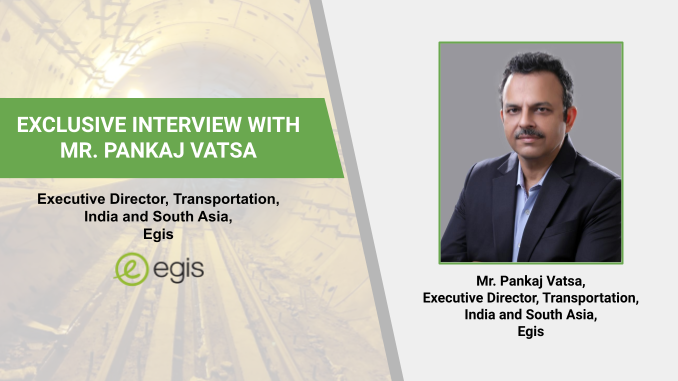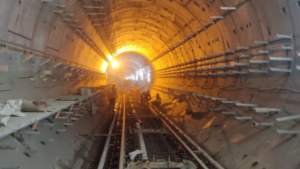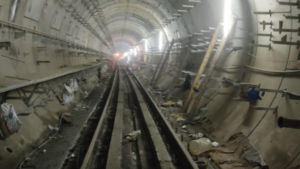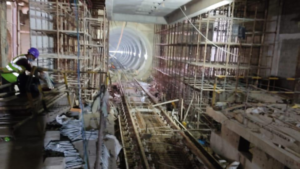
Interview Insights:
Rail Analysis: Recently, Egis won the Kochi metro phase 2 Detailed Design Consultancy project, please share some insights of the projects and what are the key parameters of this project?
Mr. Pankaj Vatsa: Egis RAIL emerged as the most competitive and secured the responsibility to deliver their expertise in design development in the month of April 2023. The proposed network connects Ernakulam City Centre to the suburbs of Infopark and Kakkanad, which is the IT hub of Kochi over a length of 11.2 km with 11 stations.
The JLN Stadium metro station, from where the Phase II corridor starts is an existing station and the newly planned stations in the corridor are: Palarivattom Junction, Palarivattom Bypass, Chembumukku, Vazhakkala, Padamugal, Kakkanad Junction, Cochin SEZ, Chittethukara, KINFRA, Infopark I and Infopark II stations. However, Infopark II remains a future provision for KMRL.

The city of Kochi and its administration are severely impacted by major challenges due to geographical location and prevailing habitable conditions like 1) Heavy Rainfall leading to ingress/seepage of rain-water into the structures and dampening of the walls/ACPs, 2) less adaptability of metro infrastructure by the locals, 3) lack of multimodal integration and last mile connectivity, 4) High platform access time for existing corridor metro stations, etc. which has raised the alarm.
This has altered the generic mindset to adopt the very conventional metro station designs and paved the way for innovative approaches. The team of Egis have taken a bold and holistic approach to address all odds and to deliver the best.

The main objective is to design to a target cost and Egis team is using value engineering concepts to produce most optimised and passenger friendly design The scope of work widens from conceptualization of the stations, entry/exit, and other ancillary structures to comprehensive detail design across major domains viz. Architecture, Structure, Mechanical, Electrical and Plumbing (MEP).
Not only limited to the above, but Egis is also entrusted with the responsibility to deliver their design expertise across Streetscaping, Landscaping, Station Access Road/Junction Development, Multimodal integration, Non-Motorized Transport (NMT) Corridor (Stretching up to 1.5 Kms for any one location), Canal Area Development Planning, etc.
Rail Analysis: In 2022, Egis had started an initiative on tackling climate changes & inviting NGOs to submit their ideas & Projects. What is the main focus of this initiative & what has been the progress on this?
Mr. Pankaj Vatsa: Egis is committed to working towards the most important areas of contribution under its CSR policy and the environment is one of the key areas of contribution. Climate change is real, and it is high time that nations and organisations act on the ground to bring about the much-needed change.
While every citizen should be responsible for safeguarding our environment, organisations also must contribute to the cause. As a Responsible Corporate Citizen, the CSR Committee of Egis in India, among other opportunities, chose to support the “Egis Clean And Green” drive in Gurgaon along with the NGO partner, “Hara Jeevan”.
“Creating a green ecosystem: Egis in India’s “Project Clean and Green” focused on adopting a Green Belt – cleaning the designated area and turning it Green by planting trees. Taking this thought ahead, Egis has adopted a piece of land in NH 8 and started the campaign with #cleanliness Drive in June 2022 and #EgisCleanAndGreen drive in August 2022. Already planted more than 2000 saplings, created a medicinal plant zone, artificial bird nests and water for birds are placed, creating awareness on climate change and environmental sustainability by inviting college & school children regularly.”
Rail Analysis: What are the specifications in this project? How does this project differ from other metro rail projects?
Mr. Pankaj Vatsa: Specifications of the Project – Bengaluru is the fifth largest metropolis in India and one of the fastest growing cities in Asia. Bengaluru because of its role as India’s leading Information Technology (IT) exporter is known as the “Silicon Valley of India” or “IT capital of India”.
Bengaluru Suburban Railway Project (BSRP) is a flagship project being helmed by K-RIDE, a JV of Govt of Karnataka and Ministry of Railways. The 4 corridors of BSRP: 148 kms of Broad Gauge, Railway Suburban corridors with 60 kg Rails track, 57 stations, and 2 depots, will act like a connecting bridge between Rural and Urban areas.
“The objective of the Project is to act like a connecting bridge between Rural and Urban areas while promoting sustainable development of the Bengaluru Sub-urban agglomeration. The 57 suburban stations will be enabled with Metro-like facilities and promote smart card-based cashless travel for suburban Railway users.”
BSRP will provide a delightful travel experience with air-conditioned RS (Metro-like with automated double-leaf sliding doors), on 25 kV AC OHE traction, station LT Power distribution, Signalling System, Telecommunications, Platform Screen Doors, Automatic Fare collection system enabled with Metro-like facilities and promote smart card-based cashless travel for suburban Railway users with Multi-modal integration and interchange with existing/ newer BMRCL stations.
Minimum land acquisition required as the running of Suburban Railway is along with the existing Railway network of Bengaluru.

BSRP will integrate multiple modes of transport and provide a convergent transit solution. At BSRP stations, passengers will be able to interchange smoothly and transfer to other modes of transport like Indian Railways, Buses, and local Metro Rail network.
BSRP will link Bengaluru City to its satellite townships, suburbs, surrounding areas and support the suburban Rail transit system. BSRP project able to cope up with the expansion of the city resulting in traffic decongestion and long commuting time for residents.
Rail Analysis: We have observed several international companies also carry out designing of global projects in India? Has that also been the strategy at Egis? What is the future growth you envisage of Egis in India?
Mr. Pankaj Vatsa: Egis has opened EDCI (Egis Design Centre India) in Gurgaon, India. The centre would cater to the Group’s international businesses. Design centre of Egis India will get the opportunity to work for global projects, to get the best of training and skill development on the best-in-class projects located outside of India as well. This corroborates the company’s trust in India’s capabilities and technological prowess. Opening a Global Design Centre in India is a testimony of our Capabilities of world class delivery.

Rail Analysis: How is Egis promoting smarter and greener mobility ideas in the metro and railway sector of india? What significant developments and innovations are needed to be adopted?
Mr. Pankaj Vatsa: Economic appraisal of a project starts from quantification of measurable economic benefits in economic money values, which are basically the savings of resource cost due to introduction of the metro line. Economic savings are derived from the difference of the cost of the same benefit components under ‘with’ and ‘without’ metro line.
Total net savings/or benefit is obtained by subtracting the economic cost of the project (incurred for construction (Capital) and maintenance (recurring) costs for the metro line) from the benefits out of the project in each year. Then the benefit value which would be negative during initial years becomes positive as years pass. Internal rate of return and benefit cost ratio are derived from the stream (components).
Benefit Components Due To Metro:
- Annual Time Cost Saved by Metro Passengers
- Annual Fuel Cost Saved by Metro Passenger
- Annual Vehicle Operating Cost Saved by Metro Passengers
- Emission Saving Cost
- Accident Cost
- Annual Time Cost Saved by Road Passengers
- Annual Fuel Cost Saved by Road Passengers
- Annual Infrastructure Maintenance Cost. The details are given in Annexure-1.
Further, rooftops of the metro stations and open spaces of the depots are proposed for installation of solar panels for generation of solar power.
Rail Analysis: What is your take on the future of infrastructure and technology of Indian metros by 2030? What are the new technologies and sustainable mobility processes that must be implemented?
Mr. Pankaj Vatsa: Metro Rail Transit Systems are now widely accepted as an alternative to mass transport in urban India because of its huge population, heightened vehicular traffic and increasing pollution. Metro in India will continue to become a dominant mode of transport in the future.
For the GC/DDC assignments – The assignments are likely to grow with additional cities that will have Metros in future, but the size of these Metros will be smaller and may be like LRT or only 3 coach metros, this means lower turnover for consultancy. Indian Railways are also coming up with GC assignments primarily to meet the technical manpower shortage for their construction organisation, new lines, conversion to high-speed routes, widening of gauge and the station redevelopment.
These are priced on a lower side and permit a very wide window for the new entrants from the road and infrastructure areas as well. The present trend of awarding the O&M by the Metros will grow progressively and the revenue in this stream will increase manyfold.

The O&M being a Manpower management venture with technical expertise and domain knowledge will be a major area of growth. Not many established players amongst the competition are having these initial credentials but the smaller segment players supplying train operators, maintainers and other support staff can be a good support as JV or as sub con having presence in the field as well as industry exposure. It will be excellent to take the early advantage and enter this area having sustainable/long term relationships and project tenure.
This Interview is a part of our latest Magazine: Subscribe to our Magazine Today!

